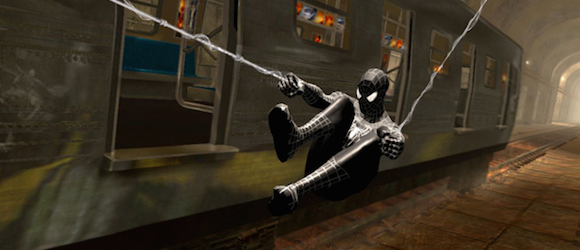Spider-Man’s Web: Explained by Science!
My Spidey Sense Is Tingling

Spider-Man’s webs are pretty impressive, capable of supporting Spidey’s weight as he swings through New York, trapping super-villains and even suspending cars above city streets. What are they made of? And how are they made?
Spider webs are notoriously strong, with spider silk reported as having a tensile strength of up to 1.75 gigapascals (GPa), or just over 178 kilograms per square millimeter in cross-section (to save U.S. readers from looking it up, 178 kilograms comes to 392.4 pounds). Tensile strength is the amount of force a material can withstand when being pulled before it breaks.
But can the strength of a specific material alone account for the properties of Spidey’s web?
“The actual material that makes up the web would likely be only part of the equation,” says Suveen Mathaudhu, a program manager in the materials science division of the U.S. Army Research Office, adjunct materials science professor at NC State and hardcore comics fan. “The web structure at a variety of length scales would also be enormously important.”
Because Rhett Allain, at Wired.com’s Dot Physics blog, has already done a great job of talking about the physics of the webslinger’s web, we wanted to talk about the importance of how the web is structured.
Mathaudhu notes that Markus Buehler, an MIT professor who has done research on spider silk, reported in 2011 that the unique alignment and confinement of the nanoscale fibrils in spider silk explain the paradoxical strength, toughness and extensibility that we see in what would otherwise be a weak material.
“Think of bridge cables or climbing ropes,” Mathaudhu says. “They’re not just a bundle of parallel fibers; they’re a collection of hierarchically arranged fibers that are interconnected in a way where friction and bonding between the fibers improves their performance.”
So, the structure of the web is clearly important. But what is the web actually made of?
In his post, Allain hypothesizes that the web may be made of carbon nanotubes. If so, we may see something Spidey-esque sooner rather than later.
“Horatio Espinosa, a professor at Northwestern University, has been studying how to hierarchically bundle and link individual carbon nanotubes with high energy irradiation in a way that improves the nanotubes’ overarching strength, stiffness and toughness,” Mathaudhu says. (And if a radioactive spider could turn a regular guy into Spider-Man, maybe it can do something similarly spectacular for carbon nanotubes?)
In short, comics (and movies) may be best enjoyed by suspending our disbelief. But the fact that they can also inspire us to ask questions about what is possible is also worth celebrating. In this case, it reminds us that form does affect function – and that researchers are working on projects that could amaze (even if they don’t create Spider-Man’s webs).
This article originally appeared on NC State University’s The Abstract under the name What Makes Spider-Man’s Web So Strong? and is reposted with permission.
- Why Captain America’s Shield Is Basically a Star-Spangled Supercapacitor
- This Is What Science Looks Like At NC State: Ann Ross
- This Is What Science Looks Like At NC State: Doreen McVeigh
Are you following The Mary Sue on Twitter, Facebook, Tumblr, Pinterest, & Google +?
Have a tip we should know? tips@themarysue.com